“Photographer: Lieut.D.I.Grant – Roll 84 and 85 – 19 Aug 44
Location: St.Lambert sur Dives
Story: “B” Coy Argyll Sutherlands have a field day with Jerry.
Today we got as far as Trun and find it well in the hands of the 4th Div a rumour was circulated that the Americans had linked with The Canadians at St.Lambert Sur Dives – we made the run to the town and found the 54 men of “B” Coy Argyll and Sutherland Highlanders capturing and controlling the town with a terrific number of prisoners. We joined them shortly after noon today.”
The actions of Major David Vivian Currie at Saint-Lambert-sur-Dives earned him the Victoria Cross, and an important part of the story is a photograph taken by Lieutenant Donald I. Grant MC of the Canadian Film and Photo Unit. The photograph was captioned by Colonel C. P. Stacey in his official history “…as close as we are likely to come to a photograph of a man winning the Victoria Cross.” Currie’s medal was purchased in 2018 for the Canadian War Museum so that it would be available to all Canadians.
What has not been available to Canadians is the cine footage that goes with the photograph. Off to the left edge of the frame in Grant’s photograph, and often cropped out, is Sergeant Jack Stollery MM filming the scene. Somewhere to the right and with the jeeps is another cameraman, Sergeant Lloyd Millon. Somehow their footage was never made available to the Canadian public, despite it being one of the most dramatic scenes filmed in Canadian history. Fragments of the footage can be seen in the Canadian Army Newsreel, and in “Canada at War: The Norman Summer”, but the most stunning scenes are missing and what remains is intercut with other events which obscures the story behind the footage. The two examples where most of the footage is still largely intact are with foreign newsreels and still there is no recognition of the significance of these scenes.
The photographer, Donald Grant, only took fifteen photographs, frames 38872 through 38886, that day with his Speed Graphic, a bulky and complex camera that took generously-sized 3¼ by 4¼ inch negatives. Frame 38879 is the famous photograph. The cine cameraman seen on the left of the frame 38879, Jack Stollery, shot four rolls of one hundred feet, his rolls 34 through 37. The other cine cameraman, Lloyd Millon, shot another three rolls, his rolls 47 through 49 with his last roll being censored. Nothing of that last roll survives. The day ended badly for the film and photo section when everyone in their party, except for Grant who had been wounded the previous month, were wounded by German machine gun fire on the way back to their camp. They were pinned down for five hours before they could get themselves out of chaos of the Falaise Gap.
Why was the footage suppressed? My best guess is that it was suppressed in order to avoid the perception that Currie was awarded the VC because he had been lucky enough to have someone film the drama of that day. Currie appears several times in the photographs and cine footage wearing his camouflaged helmet and with his revolver in hand while taking prisoners in at least two incidents. I believe he is in front of the the cameras so often, not because he was seeking publicity, but because he was making himself visible to his men. This isolated group of Canadians were at risk of being swept aside by the stampede of Germans trying to escape the Falaise Pocket and Currie’s men needed him to set an example of courage.
His courage was not unique that day. The Poles were fighting even harder just down the road, but only a handful of photos were taken during that action and the Victoria Cross was not available to them as they were not serving under our King. They were in a such a desperate state on Hill 262, the Maczuga, that they did not expect to survive the night as waves of Germans tried to eliminate them from the hill top. I suspect one of the reasons Millon, who spoke Polish, went to Saint Lambert was in case the film and photo section made contact with the Poles. However the allied units trying to block the German retreat could not keep in reliable contact with one another until the next day and the Poles might as well have been on the other side of the planet.
Curries investiture for his Victoria Cross at Buckingham Palace was, in contrast, covered in detail and was striking because he refused to change out of his “pixie suite”, the insulated overalls worn in battle by soldiers in the Armoured Corps. His refusal to abide by the tradition of presenting himself in a clean and pressed uniform can be interpreted in many ways. Likely it was not meant disrespectfully, but that he felt that taking time to see the King in London was just taking him away from doing his duty. By then the Allied victory in Normandy was old news, and the cine footage taken on 19 August was of no interest to the newsreels. Sadly the original negatives were lost in the NFB fire of 1967.
Who gets medals has much to do with one’s superior officer as the bravery shown. Some officers felt that those under them were doing the job and recognizing one man’s bravery over another’s to be unfair, while other officers could be quite generous about giving their men recognition. Stollery’s Military Medal was given because of how he exposed himself to enemy fire to get the cine footage he took in Ortona. Donald I. Grant got his Military Cross because he had been wounded trying to recover the body of Lew Currie at Carpiquet. Both Stollery and Grant were recommended for their awards by their Colonel, Dick Malone.
Awards and recognition have proved to be a mixed blessing for many recipients. Once invested they are often called upon to be public figures, a job many were not prepared for. Looking at the lives of others who were awarded the Victoria Cross one often finds controversy. Smokey Smith was opinionated and a rogue which made him a misfit in the Army. Paul Triquet’s support of Quebec independence later in life embarrassed many of his peers. If these men did not have the Victoria Cross, then none of these things would be notable as they would be the kind of behaviour we would expect to find in normal individuals. Thankfully, one of the traditions of the Victoria Cross is that it cannot be taken away because their bravery stands no matter what else the individual does. A good thing too, considering the kind of trouble in which most people can find themselves.
Many veterans have expressed discomfort at being called heroes, a title which leaves little room for their humanity, and a few have made the comment that the only heroes are those they buried and left behind. A number of people identified in the photographs and footage taken in Saint Lambert did not make it home. We known McAllister was killed in action in October 1944 trying to rescue a comrade. Millon’s roll 49 was censored, but his notes identify Private Joe Hoopes of the US Army. Hoopes had escaped German captivity and found salvation with the Canadians in Saint Lambert, only to be killed in action in April 1945. Lloyd Millon himself was killed in action in November 1944 and has no known grave.
Once one becomes familiar with these images taken at Saint-Lambert-sur-Dives, one sees them everywhere, recycled in too many documentaries to count, stripped of context, and becoming B-roll material to keep audiences engaged during the telling of other people’s stories. The story behind the images was lost and the images became a mask to hide our history. After David Vivian Currie died, his wife sold his Victoria Cross for a fraction of money spent by the Canadian public to buy it back. The original footage of his actions were destroyed out of neglect. Copies of the footage are now scattered in fragments around the world.
“Prod. No. SC 1040 A
Cameraman: Sgt. Stollery.
Story: “B” Coy Argyll and Sutherland have a field day with Jerry.
Location: St. Lambert sur Dives.
Date Shot: 19 Aug. 44
Also covered by: Lieutenant. Grant. Sgt. Millon Length:400 ft.
Roll 1(Stollery, roll 34)
2 shots of prisoners being brought in by A&S Regt. Several shots of a German office as he drove into out forward lines. He evidently didn’t know how far advanced we were and he was so dumb struck that we had him stopped and unarmed before he even knew what it was all about. He came in on a m/c [motorcycle] sidecar and there was a heavy vehicle following him. They were also take prisoners.
Roll 2. (Stollery, roll 35)
Film and Photo takes more prisoners, with the help of Major D.V. Currie, Moose Jaw, Sask. of the South Alberta Regt. We found this German in the house and Major Currie at (sic) [Leiut. D.I.] Grant and myself took them prisoners. There were several shots the first one as Maj. Currie stood by the building ordering them to come out. The rest were as they kicked over a shuttered window and stepped through it into our hands. Another shot as they grouped in the road, and the last of Major Currie as he marched them away. The balance of the roll was taken of more Germans as we showed ourselves and ordered them to put their hands up they broke and ran. The first shot was as they ran but it is very short as they started to fire on us. We then brought a tank up, and it fired through the orchard, and I shot the trees tracers going in and ricocheting off the trees etc.
Roll 3 (Stollery, roll 36)
Am (sic) Argyll and Sutherland runs past a burning Sherman tank and ducks into a house for cover.
3 shots of a burning tiger tank which has just been knocked out by a Piat gun.
The A.& S run down the street advancing to the corner of another house.
Roll 4 (Stollery, roll 37)
2 shots of A & S running down the road, hugging the edges as a Bren Gunner keeps them covered as they go after snipers. An A & S fires at a sniper in the bushes up ahead. The balance of the roll was taken as we took more prisoners the majority of whom turned out to be Mongolians of some sort, whom the Germans were using as a xx labour battalion. Note: The rank of the officer captured on the m/c [motorcycle] was said to be a Capt. But from another source I am told that he was at least a Col. so I am not sure. The most of these pics were taken under great excitement and some may be a bit unsteady. Hope not. See Lt. Grants. and Sgt. Millon for more details of this show.
Prod. No. xxxxxxxxxx SC 1040 B
Cameraman: Sgt. Millon
Story: St. Lambert Sur Dives
Date Shot: 19 Aug 44 Length: 300 ft.
St. Lambert Sur Dives was attacked by “B” Coy of the Argyll and Sutherland early this morning. Capt. I. H. Martin I/c of xxxxxxx Coy Lt. A.J.Dalpe (who was wounded and carriedon throughout the day) Lt. Armour, together with 57 men, all through the day, this company has been bringing in prisoners about 1000 to 12000 (sic) [1,000 to 1,200] in all. Pte McAllister E. H. of Hamilton himself accounted for 150 prisoners “B” Coy also captured a Tiger Tank, 3 Half-tracks and a S.P. 88mm gun and one American jeep and 12 other vehicles.
Roll 1 (Millon, roll 47) Various shots of Nazi prisoners surrendering to the Argyll and Sutherland. LS Capt. Martin, firing down road where Germans refuse to give up. MS More prisoners coming in. Showing Jerry leading horse and buggy. Various shots following a patrol to clean up St. Lambert Sur Dives. A number of snipers are still about.
Roll 2 (Millon, roll 48) About two hundred prisoners, giving themselves up. MS Pte McAllister, E.H. Hamilton. Ont. in Jerry Jeep, who accounted for at least 150 prisoners. MS Prisoners arriving on top of horses.
Roll 3 (Millon, roll 49) MS Pte. Joe H. Hoopes, 39677859, Bois, Idaho of 825 Tank Destroyer Bty 3rd Armour, American was a prisoner who broke away from the Germans, saved by the Argyll and Suth. Talking to Capt. I.H. Martin (Toronto) and Major Currie, D.V. Moose Jaw. CU Pte. Joe Hoopes. MS Argyll and Suth. Boys talking to Pte. Joe Hoopes. MS Jerry prisoner with hand on hip.”
*In the interest of fidelity, I’ve included all typos in these documents.
© Ben Moogk 2021






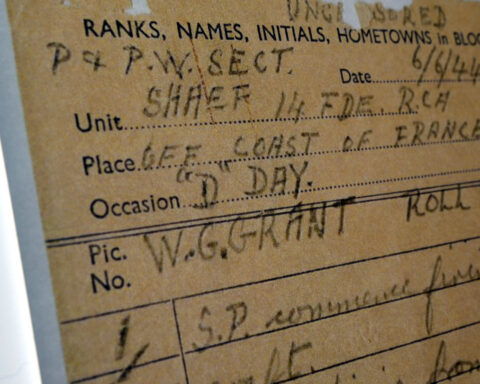
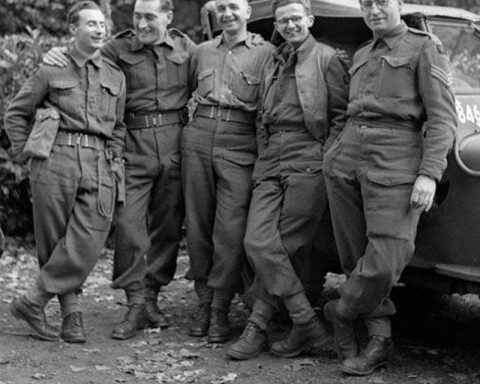


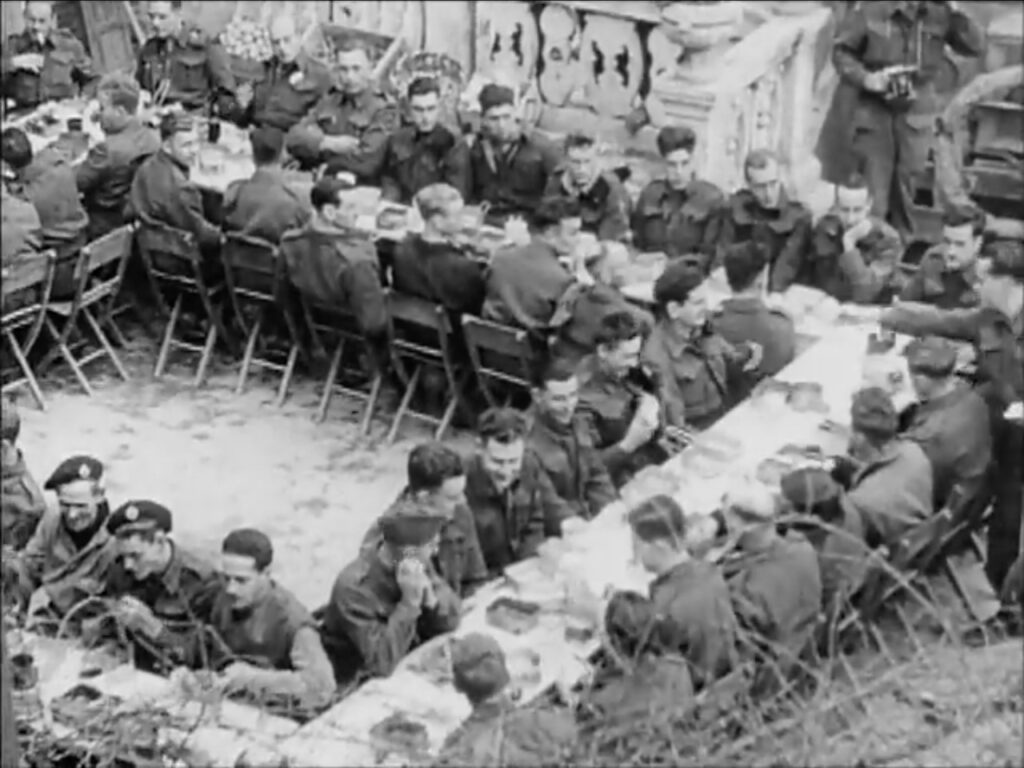
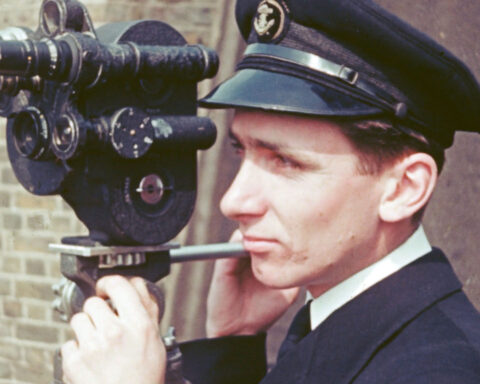

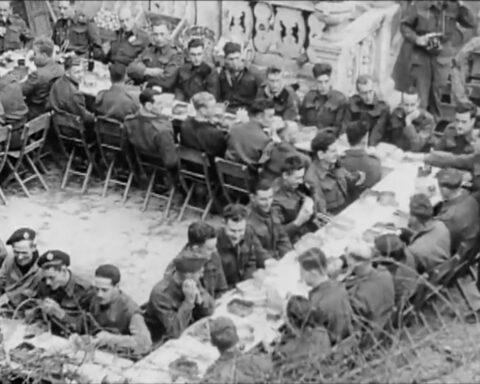

My Father is the young man shown talking with Major Currie …
His name was Sgt Garth(Pete)Woolf of the South Alberta Regiment…He was showing Major Currie a watch taken off a German soldier..He received the MM Medal. for his actions there ..thanks
Katherine
That’s incredible Katherine, thank you so much for sharing this!
Thank you Katherine for telling us this. I have heard many second-hand claims of who many of these men were, but I was careful not to repeat them as few can tell where they got the information. First hand accounts can be difficult to find. I had heard that the man next to Major Currie was of Sergeant Garth Woolf. Part of the story was that his tunic is missing and that is trouser cuffs are loose because he had been burned when his tank was hit. His tunic was charred and his ankles were raw. Have you heard of this or know a source where some of these recollections might be recorded?
That is a true story I asked him why he was in shirtsleeves and he was burned…A funny side story .
My dad and his crew ran into a german paymaster in france
They confiscated the pay role
at gunpoint and had quite the time ! They bought a hôtel (brothel) in France. Lol and they hand out german money to the locales along thè way..
Who was the German officer (name and rank, please, if known) with both hands up speaking with WO Mitchell of the A &S H of C while Major Currie speaks with the man (Woolf or Lowe) wearing the white shirt and revolver on his right thigh?
What became of the German officer’s body after he we shot by Major Currie for spitting on WO. Mitchell,
and then dragged from the road?
Any information regarding this incident would be gratefully received. Thank you for your interest in my inquiry.
Sgt (Ret’d.)A.M. Eaton, C.D.
Thanks Allan, I will forward this along to a colleague who might be able to provide some answers for your questions. Dale
Thank you, Dale! Very much appreciated.
Kindest regards,
Allan
I believe the German officers name was Rauche There are various stories surrounding his disappearance One that he ran with a number of others as they were left unescorted back to the cages Another is he was taken by partisans and executed in a barn and buried secretly
I’ve been doing more work trying to reconstruct the events and locations. The overall story is of chaos and Currie’s battle group only had a very slippery grasp on the situation. There was a prisoner of war cage just outside of town back up the hill. The battle group withdrew back to the hill that night because of constant infiltration by Germans under the cover of darkness. The River Dives wasn’t much of a barrier protecting their flank as it is little more than a creek. The hill proved only slightly better as small groups of Germans on foot roamed the countryside.